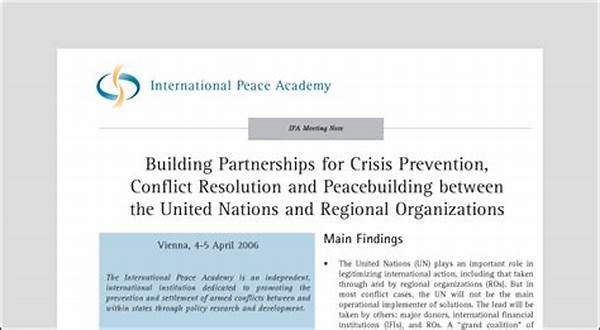In an era defined by geopolitical intricacies, military partnerships have emerged as a crucial mechanism for ensuring global stability and security. As nations confront an array of regional conflicts, the establishment and nurturing of strategic alliances among military powers have proven instrumental. These partnerships not only bolster collective defense capabilities but also serve as a foundation for collaborative efforts in regional conflict resolution. By fostering diplomatic dialogues and military cooperation, nations can address the underlying causes of conflicts and work towards sustainable peace.
The Significance of Military Alliances
Military partnerships play a pivotal role in facilitating regional conflict resolution by providing a platform for dialogue, coordination, and operational synergy. Through joint exercises, training missions, and intelligence sharing, partner nations can develop a deeper understanding of one another’s operational capabilities and strategic objectives. This mutual understanding is essential in addressing multifaceted conflicts that may arise from ethnic tensions, religious differences, or territorial disputes. A robust military partnership thus acts as both a deterrent and a pathway to conflict resolution, exemplifying the interconnectedness of modern warfare and diplomacy. As conflicts continue to evolve, so must the strategies employed by military alliances to ensure peace and regional stability.
A strategic military partnership offers numerous benefits in the quest for regional conflict resolution. First, it enhances mutual trust and operational efficiency, which are crucial for navigating complex geopolitical landscapes. Second, it allows for the pooling of resources, leading to more effective responses to crises. Third, such partnerships facilitate intelligence sharing, essential for preempting potential threats. Fourth, they provide a convening platform for diplomatic negotiations aimed at peacekeeping. Finally, military alliances contribute to the establishment of a hegemonic balance, deterring potential aggressors and creating a stable environment conducive to conflict resolution.
Evolution of Military Collaborations
The landscape of military partnerships and regional conflict resolution has evolved considerably over recent decades. Historical alliances, once primarily focused on post-war reconstruction and deterrence, have shifted towards integrated strategies that emphasize conflict prevention and long-term peacebuilding. Today, military collaborations extend beyond traditional exercises to include humanitarian assistance, disaster relief, and comprehensive peacekeeping missions. These expanded roles underscore the importance of aligning military capabilities with diplomatic initiatives in fostering durable peace in volatile regions. Consequently, military partnerships are becoming indispensable tools in the toolkit for international peace and security.
Modern military partnerships facilitate regional conflict resolution by transcending traditional diplomatic boundaries. Collaborative engagements often lead to technological exchanges and joint innovations that not only bolster defense capabilities but also strengthen regional ties. Additionally, through shared training and resilience-building exercises, military alliances foster a culture of cooperation and stability, essential for diminishing regional tensions. As a potent blend of hard and soft power, military partnerships present an opportunity to weave comprehensive strategies aimed at achieving lasting peace in regions marred by protracted conflicts.
Case Studies of Successful Alliances
Several case studies highlight the efficacy of military partnerships in regional conflict resolution. One such example is the NATO alliance, which has effectively managed conflicts through collective defense and rapid response mechanisms. Similarly, the African Union’s peacekeeping missions showcase the positive impacts of regional military collaborations in mitigating conflicts on the continent. These alliances illustrate the transformative potential of military partnerships in not only quelling immediate hostilities but also laying groundwork for enduring stability and peace. The lessons derived from these experiences underscore the centrality of military alliances in the landscape of modern conflict resolution.
The strategic alliances established in Southeast Asia and the Middle East further demonstrate the diverse approaches nations take in dealing with regional conflicts. In Southeast Asia, joint military exercises among ASEAN countries enhance interoperability and promote unity, while targeted partnerships involving Middle Eastern nations focus on counterterrorism and security cooperation. Through these initiatives, military partnerships tackle underlying issues fueled by regional disparities, thereby reinforcing efforts towards conflict mitigation and fostering an environment conducive to peace and development.
Challenges and Opportunities in Military Engagement
Despite the clear advantages of military partnerships, challenges persist that can hinder effective regional conflict resolution. Diverging national interests, historical animosities, and varying levels of military capability create obstacles in forging cohesive alliances. Furthermore, the complexities of modern warfare require unprecedented levels of adaptive strategies and technological expertise. However, these challenges also present opportunities for innovation and evolution in military partnerships, encouraging nations to reconsider and revitalize their approaches to collaboration and conflict resolution.
The dynamic nature of global conflicts necessitates a recalibration of military partnership strategies. As threats become more transnational and non-traditional, there is an increased emphasis on cyber defense, counterterrorism operations, and socio-economic stability measures. These domains present new vistas for collaboration and innovation within military partnerships. As nations work together to address these multifaceted challenges, they simultaneously strengthen the frameworks required for regional conflict resolution, promoting an era defined by security and peace.
Conclusion
Military partnerships have undeniably become an integral component of regional conflict resolution. Through fostering diplomatic relations and enhancing defense capabilities, these alliances enable nations to navigate the complexities of contemporary geopolitical landscapes. As case studies illustrate, when executed with strategic foresight, military partnerships can transform potential flashpoints into zones of peace and development. Challenges persist, but with continued dedication to mutual trust, cooperation, and innovation, military partnerships remain a formidable force for achieving regional stability and conflict resolution in an ever-changing world.





